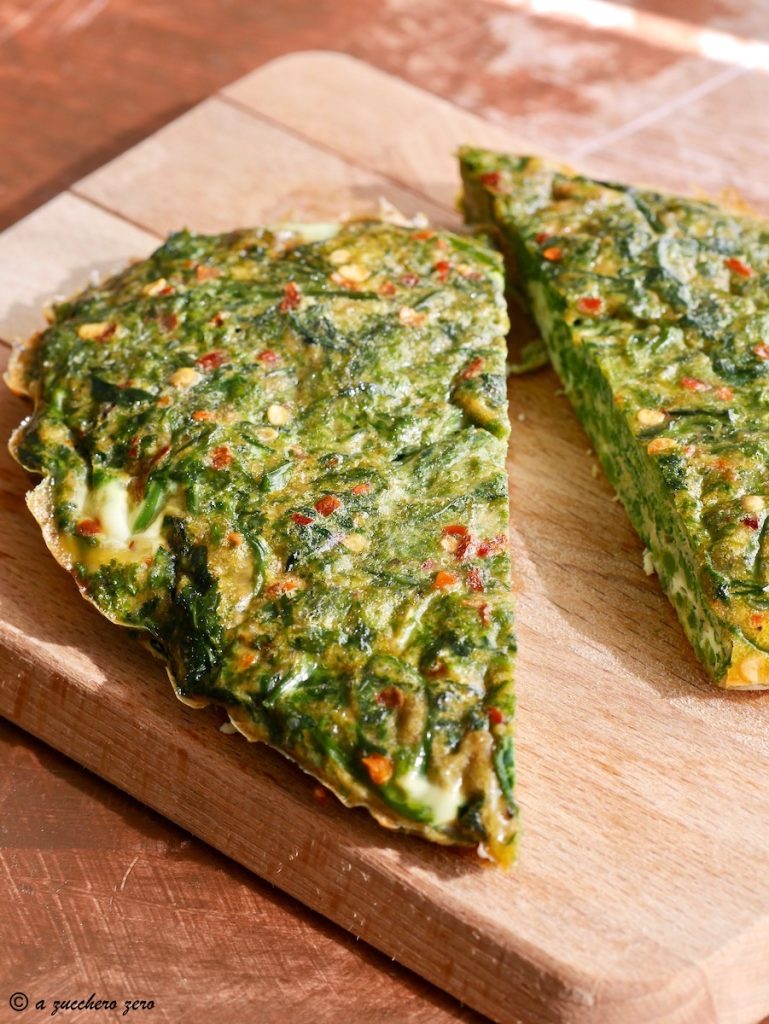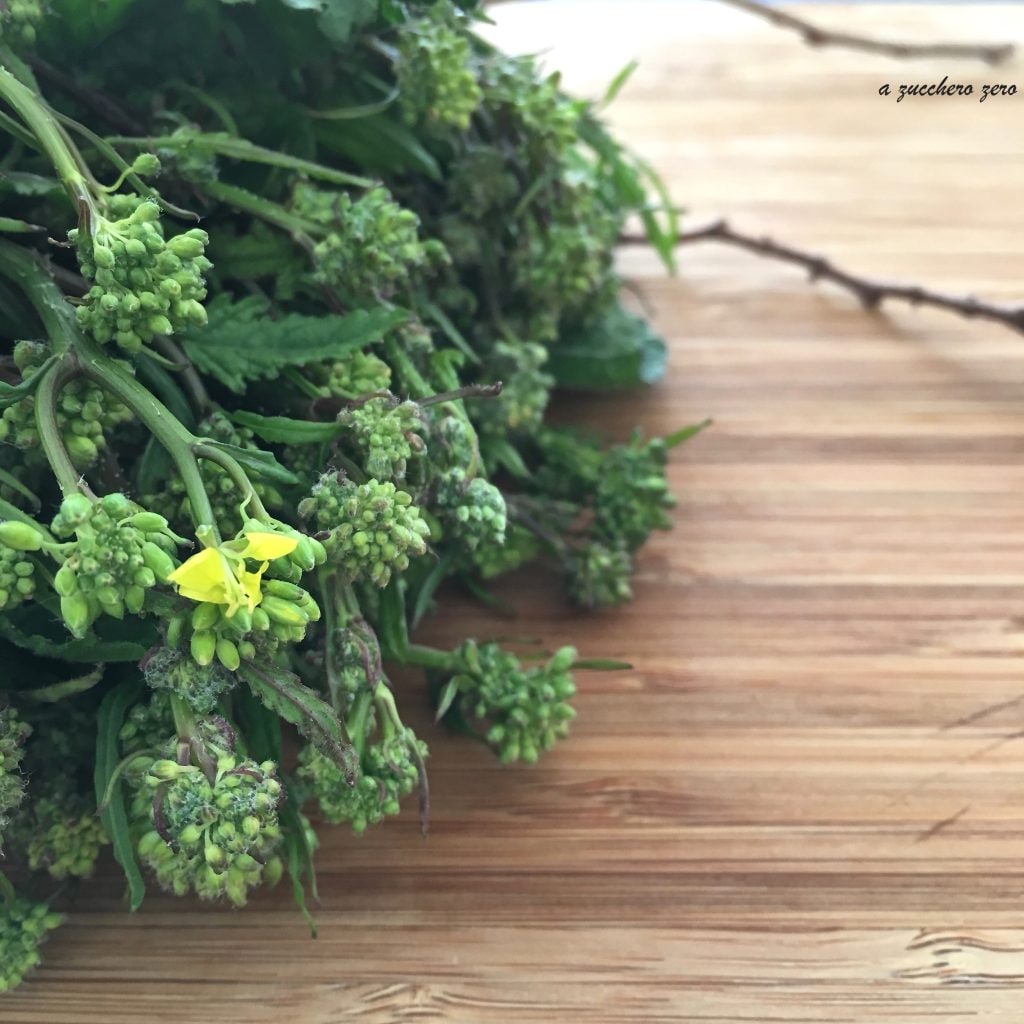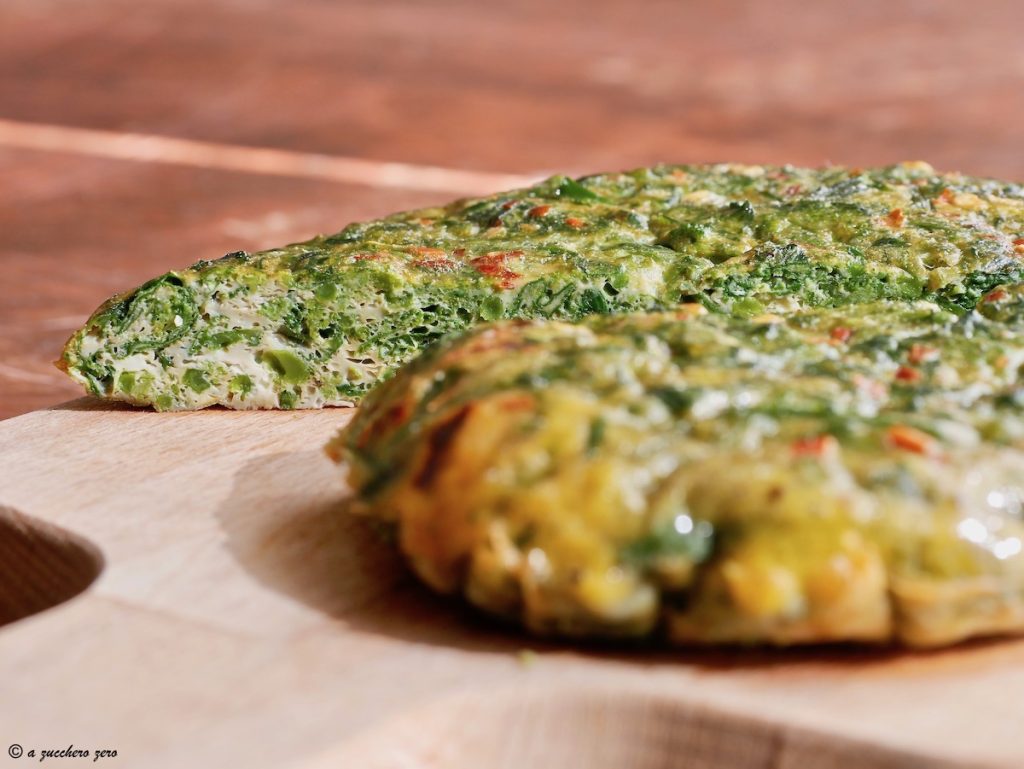The lassini or amareddi frittata mustard is a typical dish from the Sicilian table.
Lassini or amareddi mustard [Hirschfeldia incana] – family Brassicaceae are a wild herb from which the tops, leaves, and tender parts of the stem are harvested and consumed. The harvest generally takes place between March and April before the plant fully blooms. The inflorescences in bud are similar to broccoli rabe tops.
In Sicily, lassini or amareddi are variously known as: cavuliceddri, sciuriddi, cavuledda, mazzareddi, spicuna sarbaggi, qualuddru, qualeddra; depending on the province of origin.
Lassini or mustard have a characteristic, intense, and slightly bitter taste and are similar to sanapo [black mustard].
In this light version, I propose two cooking methods without added fats:
– light lassini or amareddi frittata in a pan without oil;
– lassini or amareddi frittata baked for even more convenience.

- Difficulty: Easy
- Cost: Cheap
- Preparation time: 20 Minutes
- Portions: 2 People
- Cooking methods: Electric Oven, Stovetop
- Cuisine: Italian
Ingredients
Consider one egg per person, sometimes I use two because they are small.
- 1 bunch lassini or amareddi (mustard)
- 1 pinch baking soda
- 4 eggs
- 1 pinch salt
- 1 pinch mixed peppercorns (with grinder)
- 1 pinch dried red chili (coarsely chopped)
Suggested Tools
- Bowl
- Pan non-stick with a glass lid is better
- Mold for pastiera 9.5 inches diameter
- Parchment Paper
Preparation
It’s helpful to know that washing eggs removes their protective film, making their shell, porous, more susceptible to bacteria. If the shell is dirty, clean it dry before storage and wash only before use.
What are lassini called in Italian?
lassini or amareddi mustard – family Brassicaceae.
Clean and blanch the lassini
Select the tops, tender leaves, and the softer part of the stem. Wash well under running water to remove soil.Bring salted water with a pinch of baking soda to a boil. Blanch the lassini for 5-10 minutes. Drain with a slotted spoon and squeeze well to remove excess water.
For a detailed step-by-step process, you can read the full recipe by clicking on the following link: Lassini or Amareddi Mustard.
Crack the eggs into a bowl. Add a pinch of salt to each egg and grind the pepper. Beat with a fork. Incorporate the previously blanched lassini. Finish with a pinch of coarsely chopped dried red chili and incorporate.
* I do not add cheese to the egg as I do not like the combination of the two foods, feel free to add it.
Line a baking dish with parchment paper, I usually use a pastiera mold 9.5 inches in diameter. Pour the mixture into the mold or baking dish.
Preheat the oven. Bake in a ventilated oven at 350°F for about 30 minutes, until golden.
In a non-stick pan
Preheat a good non-stick pan. Pour the mixture and spread. Cover with a lid, preferably glass, and cook on low flame until the egg is set on the surface.
If you don’t want to flip the frittata, finish cooking, making sure not to burn the base.In a pan with parchment paper
Cut a sheet of parchment paper to size, wet it, squeeze it, and place it in the pan. Pour the mixture and stir until the egg starts to set. Make holes with a fork to facilitate even cooking. When the surface is solid, flip the frittata with the help of the parchment paper and finish cooking. It takes a bit of practice, but it’s a perfect technique to avoid fats.Your light lassini or amareddi frittata is ready.
Plate it.
Enjoy your meal!

Variations
You can replicate with broccoli rabe, sanapo, or other wild bitter greens typical of your area.
FAQ (Questions and Answers)
About the Eggs
The egg is a food with high nutritional value.
Classification of eggs by weight
XL extra large: 73 g and above; L large: from 63 g to 73 g; M medium: from 53 g to 63 g; S small: less than 53 g.Can people with cholesterol eat eggs?
– cook and eat according to your dietary plan. In case of familial hypercholesterolemia it is advised not to exceed the dose of two eggs per week [source: Humanitas.it].
Dialectal Curiosities
In Sicily, the frittata is called piscirovu – fish egg or fish of egg – rolled on itself to resemble the shape of a fried fish but without fish. It was prepared when fishermen returned home empty-handed and resorted to this poor but tasty recipe. Cheese and breadcrumbs were also added to the egg preparation.

